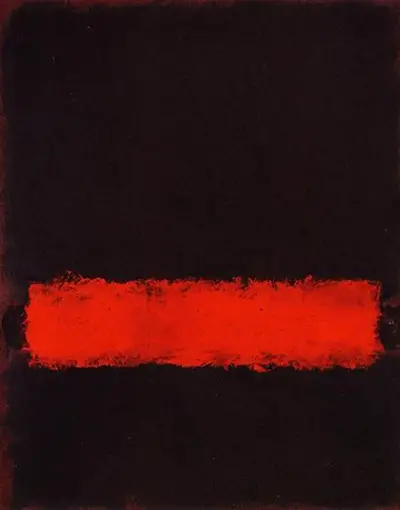Rothko delivers here a scene in which the foreground and background merge together to allow one main stripe of red to dominate your eyes. Rothko would often use warm tones within his Color Field paintings, with oranges and yellows appearing many times over. It was in the 1960s that the artist output so many works within this style, where wide bands of colour would be placed close together on large canvases. He would vary the contrast between these colours to create different effects and in this example has clearly decided to allow the foreground stripes of black to fuse fairly closely with the background. It is likely that the difference in tone will be more visible for those able to see the piece in person, and that digital photographs rarely capture the precise nuances of art within these smaller images. Thankfully, Black, Red, Black is accessible to thousands at the important Madrid gallery which continues to offer one of the finest displays of contemporary art anywhere in the world.
The artist went on a journey through his life in which he slowly started to become more and more abstract, though along the way would try out a great variety of different styles of modern art. He appeared to realise from a young age that he wanted to be innovative, but it would take a long time before he found an approach which would inspire and motivate him for more than just a few years at a time. Some work would appear surrealist, whilst others were more akin to expressionist, but slowly he pushed towards abstraction as summarised by the painting displayed here. Black, Red, Black would be finished in 1968 and he would often exhibit several of his Color Field series together for the first time every few months. It would take some time to plan these pieces even though they appear so simple, as Rothko experimented with different arrangements of shape and colour. It was this style which was to become his signature style and most think of paintings such as these when they hear of his name, in the same way that Pollock's life is linked so closely to his drip paintings.
Madrid hosts this artwork and also offers some of the finest galleries in the world, with a good mixture of modern art and more traditional styles. The Thyssen-Bornemisza Museum is very much the former and specialises most in Spanish and French contemporary art, with Cubism particularly well represented. Close by you will then find the Prado which covers the very earliest period of Spanish life all the way up to about the mid-19th century, where the likes of Sorolla are featured. It remains one of the most important displays of Renaissance art anywhere in the world and provides an excellent alternative to other museums within a relatively small part of the city. Art followers will therefore have plenty of culture to enjoy during an extended holiday here and this reminds us of the role played by the city's residents in the development of European art over the past few centuries.


